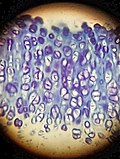Metachromasia
Property of certain biological materials to change color when stained with specific dyes
| Metachromasia | |
|---|---|
| [[File:|250px|alt=|]] | |
| Synonyms | |
| Pronounce | N/A |
| Field | Histology |
| Symptoms | |
| Complications | |
| Onset | |
| Duration | |
| Types | |
| Causes | |
| Risks | |
| Diagnosis | Histological staining |
| Differential diagnosis | |
| Prevention | |
| Treatment | |
| Medication | |
| Prognosis | |
| Frequency | |
| Deaths | |
Metachromasia is a phenomenon observed in certain biological materials where they change color when stained with specific dyes. This property is particularly significant in the field of histology and cytology, where it is used to identify and differentiate between various types of tissues and cellular components.
Mechanism[edit]
Metachromasia occurs due to the interaction between the dye molecules and the biological material. When a metachromatic dye binds to certain substances, such as glycosaminoglycans or amyloid, the dye molecules aggregate, leading to a shift in the dye's absorption spectrum. This shift results in a color change that is different from the dye's original color. For example, the dye toluidine blue appears blue in solution but stains certain tissues purple or red.
Applications[edit]
Metachromasia is widely used in histopathology to identify and study various tissue components. It is particularly useful in diagnosing diseases that involve the accumulation of specific substances, such as mucopolysaccharidoses and amyloidosis. The technique is also employed in cytology to examine cellular structures and identify abnormalities.
Common Metachromatic Dyes[edit]
Several dyes are known for their metachromatic properties, including:
Related Techniques[edit]
Metachromasia is often used in conjunction with other staining techniques to provide a comprehensive analysis of tissue samples. Some related techniques include:
See Also[edit]
- Histology
- Cytology
- Histopathology
- Glycosaminoglycan
- Amyloid
- Toluidine blue
- Methylene blue
- Crystal violet
- Thionine
References[edit]
<references group="" responsive="1"></references>
Metachromasia[edit]
-
Cartilagine ialina metacromasia
Ad. Transform your life with W8MD's Budget GLP-1 injections from $75


W8MD offers a medical weight loss program to lose weight in Philadelphia. Our physician-supervised medical weight loss provides:
- Weight loss injections in NYC (generic and brand names):
- Zepbound / Mounjaro, Wegovy / Ozempic, Saxenda
- Most insurances accepted or discounted self-pay rates. We will obtain insurance prior authorizations if needed.
- Generic GLP1 weight loss injections from $75 for the starting dose.
- Also offer prescription weight loss medications including Phentermine, Qsymia, Diethylpropion, Contrave etc.
NYC weight loss doctor appointmentsNYC weight loss doctor appointments
Start your NYC weight loss journey today at our NYC medical weight loss and Philadelphia medical weight loss clinics.
- Call 718-946-5500 to lose weight in NYC or for medical weight loss in Philadelphia 215-676-2334.
- Tags:NYC medical weight loss, Philadelphia lose weight Zepbound NYC, Budget GLP1 weight loss injections, Wegovy Philadelphia, Wegovy NYC, Philadelphia medical weight loss, Brookly weight loss and Wegovy NYC
|
WikiMD's Wellness Encyclopedia |
| Let Food Be Thy Medicine Medicine Thy Food - Hippocrates |
Medical Disclaimer: WikiMD is not a substitute for professional medical advice. The information on WikiMD is provided as an information resource only, may be incorrect, outdated or misleading, and is not to be used or relied on for any diagnostic or treatment purposes. Please consult your health care provider before making any healthcare decisions or for guidance about a specific medical condition. WikiMD expressly disclaims responsibility, and shall have no liability, for any damages, loss, injury, or liability whatsoever suffered as a result of your reliance on the information contained in this site. By visiting this site you agree to the foregoing terms and conditions, which may from time to time be changed or supplemented by WikiMD. If you do not agree to the foregoing terms and conditions, you should not enter or use this site. See full disclaimer.
Credits:Most images are courtesy of Wikimedia commons, and templates, categories Wikipedia, licensed under CC BY SA or similar.
Translate this page: - East Asian
中文,
日本,
한국어,
South Asian
हिन्दी,
தமிழ்,
తెలుగు,
Urdu,
ಕನ್ನಡ,
Southeast Asian
Indonesian,
Vietnamese,
Thai,
မြန်မာဘာသာ,
বাংলা
European
español,
Deutsch,
français,
Greek,
português do Brasil,
polski,
română,
русский,
Nederlands,
norsk,
svenska,
suomi,
Italian
Middle Eastern & African
عربى,
Turkish,
Persian,
Hebrew,
Afrikaans,
isiZulu,
Kiswahili,
Other
Bulgarian,
Hungarian,
Czech,
Swedish,
മലയാളം,
मराठी,
ਪੰਜਾਬੀ,
ગુજરાતી,
Portuguese,
Ukrainian

